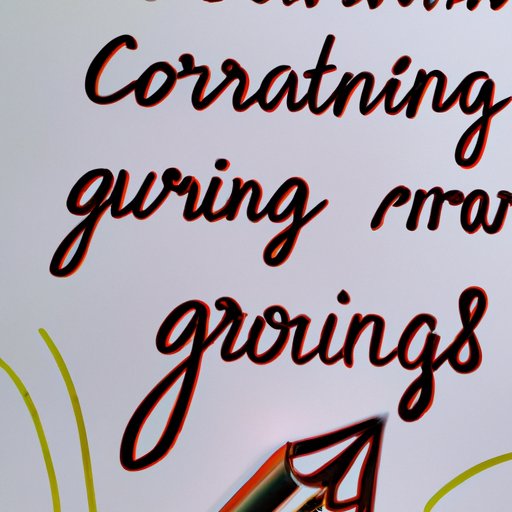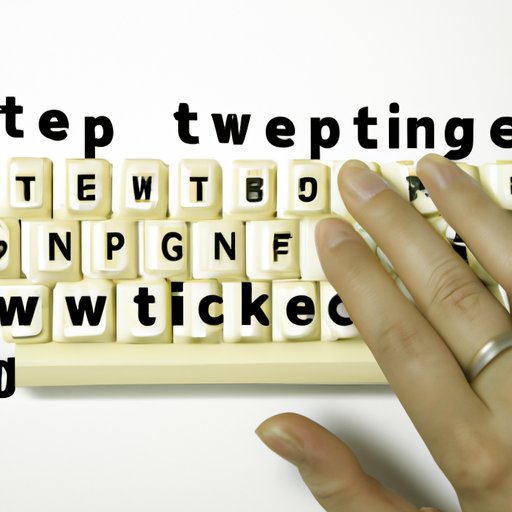Introduction
In an age when most communication happens through digital means, we are often encouraged to type our thoughts rather than write them down. But does this really provide the best results? This article will explore why writing is better than typing, and how it can help us capture our thoughts and ideas in their purest form. We will look at the benefits of a more tactile approach to writing, slower and more deliberate thinking, deeper engagement and creativity, and a more visual representation of ideas.
Writing is More Tactile
When you write something down, you are creating a physical connection with the written word. You can feel the pressure of your pen as you write, the texture of the paper beneath it, and the motion of your hand as it moves across the page. All of these elements can contribute to a greater understanding and appreciation of what you’re writing. By engaging more of your senses, you can create a stronger emotional connection to the words you’re writing, and this can lead to a better understanding of what you want to convey.
The tactile nature of writing can also be beneficial for those who struggle with dyslexia or other reading and writing disorders. Because they can feel the shape of the letters and words, they may be able to better comprehend what they’re writing. Additionally, the physical act of writing can be calming and therapeutic, providing an outlet for stress and anxiety.
Writing is Slower and More Deliberate
When you type, your words appear instantaneously on the screen. While this may seem like a good thing, it can actually be detrimental to the quality of your work. When you type too quickly, you may not be giving your thoughts enough time to process, leading to mistakes or incomplete sentences. On the other hand, when you write by hand, you are forced to slow down and think about each word and sentence before committing it to paper.
Writing by hand can also be beneficial for problem-solving. When you take the time to write out your thoughts and ideas, you are more likely to come up with creative solutions. Instead of just typing out the first solution that comes to mind, you can take the time to consider all of your options and then make an informed decision. This can help you avoid making impulsive decisions that you may later regret.

Writing Encourages Deeper Engagement and Creativity
Writing by hand allows you to focus on one task at a time. There are no distractions from notifications or emails, and you can spend as much time as you need to work through a problem or idea. This can help you engage more deeply with the task at hand, allowing for more thoughtful consideration of the issue. It can also help you tap into your creative side, as you take the time to explore different possibilities and outcomes.
Writing by hand also has the benefit of helping you stay organized. You can jot down notes and ideas as they come to you, which can help keep your thoughts and ideas clear and organized. This can be especially helpful when working on a project or task that requires a lot of planning and preparation.

Writing Can Capture Thoughts and Ideas in Their Purest Form
When you type, you may find that you are constantly editing and changing words or phrases. This can make it difficult to capture your ideas in their purest form. Writing by hand, however, allows you to get your thoughts down quickly and efficiently. You can jot down whatever comes to mind without worrying about whether it’s perfect or complete. This can be especially helpful when brainstorming or trying to capture new ideas.
Writing by hand also helps you remember things better. Studies have shown that people are more likely to remember information that they write down by hand than if they type it out. This could be because of the physical connection with the written word, or because of the slower pace of writing, which allows for more focus and attention to detail.

Writing Offers a More Visual Representation of Ideas
Writing by hand can also be beneficial for conveying complex ideas and concepts. When you write out your thoughts, you can draw diagrams or sketches to help illustrate your point. This can be much easier to comprehend than a typed document, as the visual representation of the ideas can be more easily understood. Additionally, writing can also be used to create timelines or flowcharts, which can be useful for tracking progress or outlining processes.
Writing by hand can also be useful for presentations. Instead of relying on slides or screens, you can create visuals that will be more memorable and engaging. Handwritten notes can also be used to add emphasis to certain points, or to provide additional clarity. Additionally, writing can be used to quickly capture audience feedback and questions, which can be useful for follow-up conversations.
Conclusion
Writing is often seen as an archaic practice in a world where technology reigns supreme. However, this article has explored why writing is still a valuable tool for capturing thoughts and ideas in their purest form. From the tactile nature of writing, to the slower and more deliberate pace that encourages deeper engagement and creativity, to the ability to create visual representations of ideas, writing can offer many benefits over typing. So the next time you need to communicate or express yourself, try taking a pen to paper.
This article was written for those looking to explore why writing is better than typing. We discussed the benefits of a more tactile approach to writing, slower and more deliberate thinking, deeper engagement and creativity, and a more visual representation of ideas. Hopefully, this article has provided some useful insight into why writing is still a valuable tool.
(Note: Is this article not meeting your expectations? Do you have knowledge or insights to share? Unlock new opportunities and expand your reach by joining our authors team. Click Registration to join us and share your expertise with our readers.)
